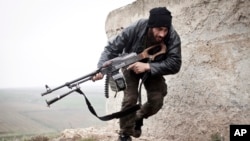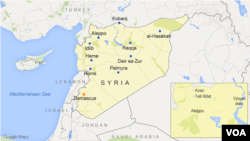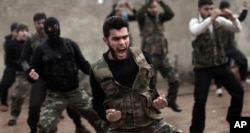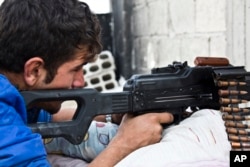Syrian rebel commander Abu Ali Sijjo has for months fought Islamic State, liberating a village along the border from the terror group, while at the same time battling Syrian President Bashar al-Assad's regime.
Two months ago IS targeted the rebel commander in a car bombing — he has a shattered shoulder and limited use of his right-arm. But as mainly moderate and Islamic nationalist rebel militias -- some backed by the U.S. -- are faced with an unrelenting Assad ground offensive, pulverizing round-the-clock Russian airstrikes and Kurdish attacks in northern Syria, even this rebel commander is questioning where his future allegiances may lie.
Most rebel fighters and commanders are debating with themselves and each other about what they should do, how they should re-group and who they should align with in defense of what is left of the dwindling territory they are clinging onto in the Aleppo countryside.
Some fighters have left the battlefield — not from a lack of valor but in anger at what they see as Western passivity — some say betrayal — or in disgust with their commanders who still squabble among themselves.
Others are pondering whether to join al-Qaida affiliate Jabhat al-Nusra or even Islamic State — not out of theological reasons but to be able to continue to fight Assad.
The picture is changing by the hour in the northern Aleppo in what one rebel commander told VOA is the “make-or-break moment of the Syrian revolution.”
Here’s a look at the "who, what, where and why" of the current situation on the ground in northern Syria and what it might portend for U.S. policy and the fate of the Syrian revolution.
Are The Syrian Rebels United?
The Syrian revolution has been marked by the fractiousness of its armed groups and political factions. In the face of impeding doom, deep divisions and disagreements remain. The former chief of staff of the Western-backed Free Syrian Army (FSA), General Salem Idris, recently expressed his frustration to VOA about the bickering that erupted during an emergency meeting between militia commanders in the northern Aleppo countryside. “They may lose everything but they still think about personal interests,” he fumed.
Over the past five years many attempts have been made to achieve some unity of purpose and alliances have come and gone with dizzying speed. As towns and villages have fallen the past week — some to the Assad regime, others to fighters with the Kurdish-dominated Syrian Democratic Forces —disputes have continued to flare, including over decisions about whether to retreat, surrender or withdraw.
In the town of Mare’ midweek some factions wanted to surrender; others refused to do so.
On Monday, eight prominent Aleppo rebel groups agreed to unite for operational purposes under the tactical leadership of Hashim al Sheikh, a former member and ally of Ahrar al-Sham, the hard-line Islamist militia which is aligned with al-Qaida affiliate Jabhat al-Nusra. Although this is not a full merger with Ahrar al-Sham, it will strengthen the Islamist group, and will likely better position it to absorb later other militias, fear analysts.
If more rebels Jjin Ahrar al-Sham or Jabhat al-Nusra, doesn’t this prove the rebels all along were extremists at heart?
Syrian President Assad has always argued that his opponents are terrorists — including political foes not even in armed groups. And that has been the constant refrain of Moscow. Since the Assad offensive started more than a week ago, that line has been echoed by the leaders of the Kurdish Democratic Union Party (PYD). Its leader Saleh Muslim declined to condemn the Russian airstrikes and Assad offensive in an interview with VOA, insisting that the Russians and regime forces were “just attacking terrorists, Ahrar al-Sham and Jabhat al-Nusra.”
The commanders of the People’s Protection Units (YPG), the armed wing of the PYD, insist the towns they have been overrunning this week are being grabbed from Ahrar al-Sham or al-Qaida fighters. But towns like Tell Rifaat were never in the hands of either Ahrar al-Sham or Jabhat al-Nusra, and fighters from al -Qaida’s Syria affiliate long ago vacated much of the northern Aleppo countryside, although in some areas they have returned since the offensive, especially in the city of Aleppo to fight alongside other rebel factions.
A rebel realignment that appears to be emerging that strengthens Salafi-Jihadist and hardline Islamist groups will be a self-fulfilling prophecy, argue many Syria watchers.
They say Moscow has been pursing a strategy it used in Chechnya: target the moderates and crush them, which in turn leaves only extremists remaining, allowing the regime to force people and foreign governments to choose between either the regime or the extremists with no moderate alternative.
“It is straight out of the Kremlin playbook: destroy the middle ground, back us or back the extremists,” says a senior European Union diplomat.
With the noose tightening around the city of Aleppo and militias on the back foot in the countryside to the north of the city, many rebel fighters will have no option but to join the bigger more powerful groups like Ahrar al-Sham or al Nusra or align with them, says Bassam al Kuwaiti, a well known figure in pro-opposition civil society circles. “They will follow anyone who can pay them and give them a gun and ammunition,” he says. “They will also have to do so for self-protection reasons,” he adds.
Where do the Kurds come into this?
The YPG dominates the so-called Syrian Democratic Forces. Some Sunni Arab and Turkmen militias are also members of the SDF but several have checkered histories and have formed opportunistic alliances in the past with rebel militias they are now fighting. Some have even worked with jihadists in the past. Some fighters are from Western-backed militias such as the Hazzm Movement and the Syrian Revolutionaries Front, which collapsed last year after being attacked by by Islamist militias and al-Nusra.
The SDF, which was unveiled in October, was embraced by U.S. officials as a proxy army to partner with in northern Syria to fight Islamic State and was seen by Washington as an alternative to a ground force the Obama administration had hoped to recruit from scratch and train and equip.
Until the Assad offensive, the Kurdish-dominated SDF focused on fighting IS to the east of the Euphrates River and received arms supplies from the U.S. to do so. But in December it seized the Tishrin dam from the terror group and some of its fighters — to the anger of Ankara — crossed west of the river. There were signs SDF fighters would move into the Aleppo countryside. PYD leaders have made little secret they want to unite Kurdish cantons along the border.
Once the Assad offensive started SDF fighters — mainly Kurdish — launched attacks on FSA and other rebels in the Aleppo countryside not from the East but from their enclave at Afrin to the West, seizing at first a couple of villages. But they have quickly expanded, exploiting the Assad offensive and Russian airstrikes, which noticeably have not been targeting them, to seize more towns and territory, including a major airbase that has been in rebel hands since August 2013. This week they occupied the strategic town of Tell Rifaat, just 15 kilometers form the border with Turkey.
YPG commanders — and the PYD’s social media propaganda machine — deny the Kurdish action has been coordinated with the Assad regime or the Russians. They contend they have sheltered Arab Sunni families who have fled heavy fighting in the Kurdish enclave of Afrin and by taking towns are ensuring they are denied to the regime.
Syrian rebel commanders, however, insist there has been clear military coordination, and say they will never forgive what they consider treachery by the Kurds.
The spectacle has been bewildering of U.S.-backed Kurds — who now appear to be Russian-backed, too — battling U.S.-backed rebel militias, prompting head-scratching from some analysts and triggering loud accusations from rebels that Washington and Moscow are in league with each other. The Obama administration has urged the Kurds to restrain themselves but the rebels say that if Washington really wanted the YPG to stop it could exert more pressure.
Where does this Leave the US ?
The realignments and shifts will impact U.S. strategy in Syria, say analysts. The Obama administration has made the defeat of the Islamic State its top priority in Syria and has argued only a political solution and not a military one can resolve the five-year-long civil war that has left upwards of 250,000 people dead. It has been reluctant to get drawn into the civil war, although it has wanted to see Assad’s ouster.
But some analysts warn that even the U.S. objective of defeating IS will be undermined by the events of the past week. “The U.S. requires partnerships with Syrian armed opposition groups in order to destroy ISIS and al-Qaida affiliate Jabhat al Nusra in the long term,” warns analyst Jennifer Cafarella in a paper for the Institute for the Study of War, a Washington-based think tank.
“Without local Sunni partners that hold the support of the population, the U.S. faces high costs to destroy ISIS and al-Qaida in Syria and risks failure,” she says.
Rebel commanders say that the U.S. will find fewer militias trusting it in the future. “America by its inaction is pushing fighters to join IS or Jabhat al-Nusra,” says Abu Ali Sijjo. “They are pushing us towards extremism,” he warns.
What is Turkey doing?
Turkey’s leaders have long argued that Western policy has been flawed and that IS can’t be vanquished until Assad is ousted. The two are connected, they say, and extremists will thrive in the chaos of the civil war. They lobbied last year for the U.S.-led international coalition to carve out a safe haven for the rebels — and civilians — in northern Syria. Last autumn, it looked as if Washington would agree to this in return for the use of a NATO airbase in Turkey for coalition warplanes striking at IS. But after weeks of talks Washington decided against establishing a safe haven.
Turkish and Gulf allies such as Saudi Arabia have been lobbying for a ground force to intervene in Syria but in recent days they have made it clear that such a force would have to be agreed by the coalition and there are no signs of Western appetite for such an intervention. Now the Turks are calling for a smaller safe haven to be established around the border town of Azaz to protect the tens of thousands of displaced civilians there — and to avoid the Turks having to open the border to admit them.
The Turks have warned also they will not tolerate the Kurds expanding their territory in the Aleppo countryside and are continuing to shell YPG positions. The shelling though hasn’t stopped YPG advances. And, according to the rebels, isn’t helping them either as it is it not deterring the Russian airstrikes.















